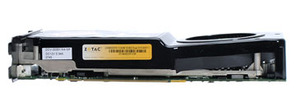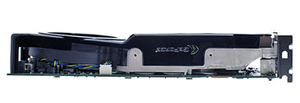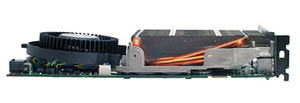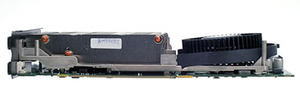Heatsink Design:
Before we get onto the design itself, it’s worth briefly talking about how well the design works from the perspective of both cooling performance and a noise pollution. Thankfully, Nvidia’s reference heatsink follows on from previous designs in this category with the GPU temperatures well within tolerable levels when in both an idle state and when loaded at stock speeds.Additionally, the fan didn’t spin up at all during our testing and, if you’re already a GeForce 8-series owner—or even a GeForce 7900 GTX owner for that matter—you’ll know how quiet Nvidia’s dual-slot cooling solutions have been for the past couple of years.
One complaint that has cropped up time and time again was to do with the fact that the top card in an SLI configuration often had less than optimal airflow because it was hindered by the card directly below it.
The GeForce 8800 GTS 512’s cooler addresses this by tilting the fan slightly to increase the amount of room between the fan and a second card in an SLI configuration. That’s not the only benefit of this heatsink design though, as the tilt also means that air is now pushed onto the heatsink that comes into direct contact with the GPU core, which should help to improve cooling performance a bit.
Nvidia has also removed the vents at the end of the heatsink shroud that’s nearest the PCI bracket - there was never any real benefit to them in my opinion anyway. The only thing I could see them doing was ensuring some of the heat wasn’t exhausted out the back of the case.
Aside from these changes, the design appears to follow a similar ethos to the one used on the GeForce 8800 GT – that’s to be a bit more consumer-friendly. There are fewer components visible as the heatsink’s black glossy plastic shroud covers almost the whole of the front of the PCB. There's also GeForce logo along the top edge of the heatsink so that it’s easy for admirers to distinguish what graphics card is installed in your system.
The shroud is held in place by five screws on top and another three underneath at the same end as the card’s power circuitry. Once these are removed, the rest of the heatsink’s design is revealed.
In many respects, it’s very similar to the Cooler Master-designed heatsink that Nvidia used on its other GeForce 8800 GTS cards, but instead of just the one heatpipe, there are now three. These all sprout from the copper insert that comes into direct contact with the GPU and help to dissipate the heat in a more efficient manner than simple convection.

MSI MPG Velox 100R Chassis Review
October 14 2021 | 15:04














Want to comment? Please log in.